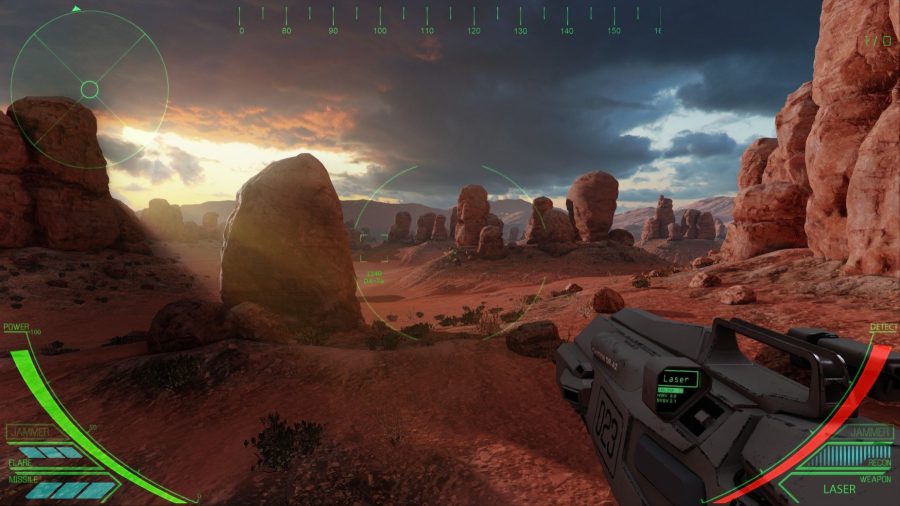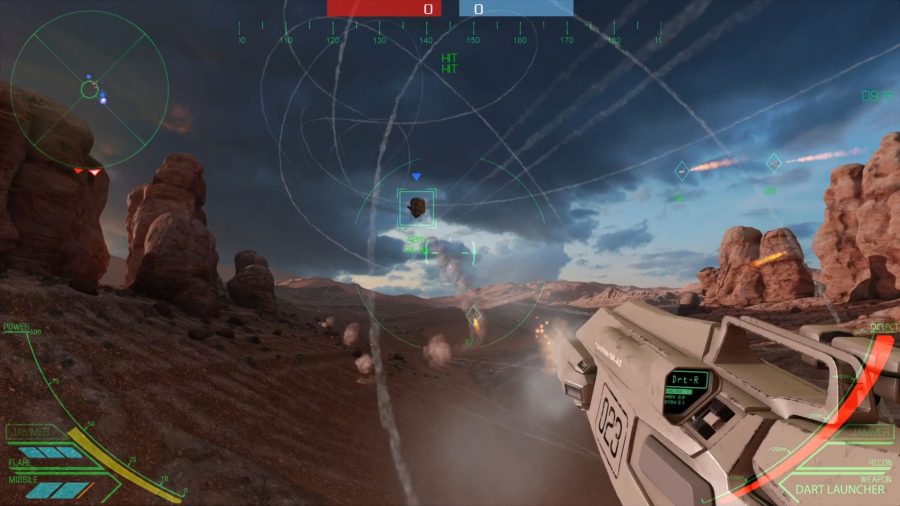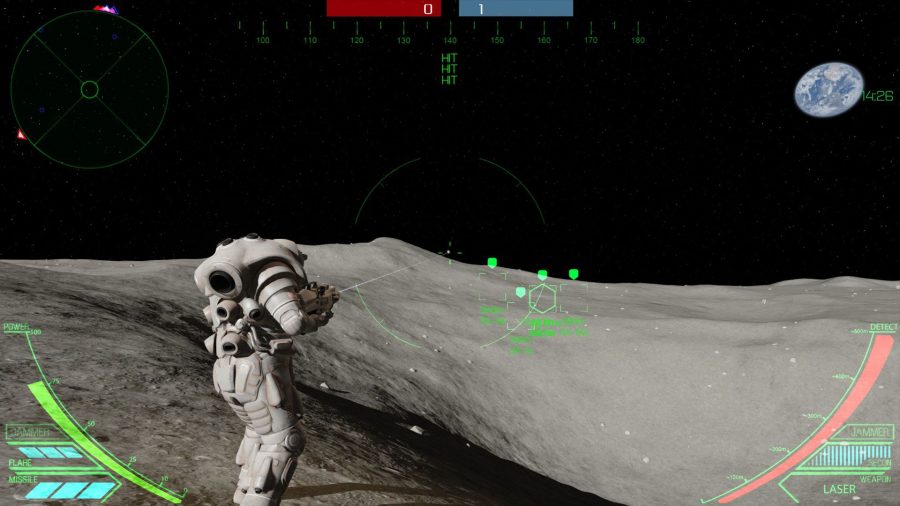The word ‘unique’ gets used a lot, but Exocorps shares very few of its defining features with any other game. It’s a multiplayer arena shooter in which the arenas are huge and opponents are few. Flight is “absolutely fundamental” to its movement and combat. Perhaps most unusually of all considering it’s 2020 and Unreal Engine 5 is around the corner, it’s made in Unreal Engine 3.
“ExoCorps is made in UE3 for the simple reason that UE4 didn’t exist when I started it,” technical director Garin Mazaika tells us. “I first started work on it in 2010, and the other real option for what I was envisioning was Unity. However, at the time UE3 appeared to have a content pipeline that was much closer to the sorts of tools that I had already worked with, so the learning curve looked easier. But the real benefit was that it was an engine built around a multiplayer arena shooter, and I wanted to make a multiplayer arena shooter.”
Sounds reasonable enough. Mazaika describes the idea for ExoCorps as “ancient”, explaining that it goes back to “hanging out at the local tabletop wargames club around 2004ish. It stems from a combination of the books Starship Troopers, Hyperion, and Forever War. Throw in some Top Gun and Macross for the dogfighting aspects, and some Star Trek for teleportation, and you got the ingredients for our power armor stew.”
Mazaika, his wife Rachel Fenn, and software developer Sam Seltzer-Johnston comprise the tiny indie studio, Gingerbred, that’s working on this distinctive vision. The announcement trailer sells it well, depicting a breathless airborne duel in a vast canyon, but we’ve got a lot of questions. For one, with such big maps and few enemies, were the team worried about creating long stretches of action-free gameplay?

“Players not being able to find each other was definitely a concern, and the HUD and the Detectability system are part of our solution,” Mazaika says. “Normally it would be tough to spot a human-sized target in such a large landscape, but the more you fly or shoot, the more ‘Detectable’ you become. That gets combined with in-world proximity to determine whether or not you get highlighted on an opponent’s HUD.
“If you’re impatient to find somebody, you can also send out a radar blast that temporarily raises everyone’s Detectability at a huge cost in Power, which in turn makes you more vulnerable. There’s also a Jammer ability, which represents electronic countermeasures. This creates a sort of soft-stealth gameplay – cagey players can sneak around the map to find lookouts to scan visually for each other, which can get pretty tense, but if aggressive players want to find targets immediately, they have that option too. It also gives another way to tune weapon balance, as some weapons have a higher ‘Detectability cost’ than others.”
Another potential issue: we need to hear more about these jetpacks. Where they exist in shooters already, we find them mostly unsatisfying – too ‘floaty’ and not as empowering to use in practice as the idea of personal flight would suggest. What makes them different in ExoCorps?
“I think a lot of shooters treat a jetpack as an ‘additional’ mechanic, rather than a ‘core’ mechanic that weapons, abilities, and level design is built around,” Mazaika says. “A lot of the risk for that floaty feel usually comes from two things, the first being low flight speed. That’s easy to solve by just turning up the player speed, but then you need weapons that can cope with hitting small targets that are moving quickly. Our weapon modes are specifically tuned for that.
“The second barrier to feeling like you’re moving fast is that the sensation of speed is relative, which means you need to fly past stuff to feel fast. This ties in to one of the main reasons behind Detectability and the Missile Swarm ability. When you’re flying, Detectability spikes and opponents will be able to find you easier, can acquire a Lock, and fire a Missile Swarm at you. The Missile Swarm is the anime-style swirly missile attack that tracks its target aggressively. Besides looking cool, the Missile Swarm is a very easy-to-use countermeasure to flying.
“This winds up actually benefiting the feeling of flight because flying becomes riskier, and therefore more exciting, but it also encourages players to keep low and ‘fly past stuff’. If you want to avoid Lock, and if you want to defend against Missile Swarms, skimming the surface of the level and weaving in and out of rock formations is the thing to do. It’s intended as game-mechanic encouragement to enhance the feeling of speed by flying low, without actually limiting a player’s ability to fly high if they want to.”
These are highly detailed answers that suggest a clear vision for the game – one that goes beyond just the surface fun of jetpacks and big maps and speaks to capturing a particular experience. “The feeling I wanted to achieve was to make high-skill duelling particularly dynamic,” Mazaika says. “That stems from certain Macross scenes, but also from lots of time spent in long 1v1 matches in Doom 2, of all things. There’s a great tension in a prolonged duel where both players have openings for attack, and are matched in response with appropriate defensive manoeuvres. I also just really like astronomy, so our maps are pushing out into the solar system, and if all goes well, beyond.”
Read more: Check out the best FPS games on PC
When it comes to achieving all this at a technical level, we’ll admit that UE4 not existing is a pretty good reason for not using it to make your game, as these things go. But we’ve spoken to many developers for this series who’ve raved about tools that sound perfect for ExoCorps, such as its level streaming technology, which could help Gingerbred create its vast maps while reducing their memory burden. Why did the team choose not to upgrade?
“At the time UE4 was beginning to gain ground, we had just finished the foundation of ExoCorps and started the first network playtesting among friends,” Mazaika says. “We had literally just gotten the game into a semi-reasonable, playable state. We were also looking at the end of our ‘honeymoon period’ of development when we could both work on it full-time, which meant velocity was going to slow down. So UE4 was really cool-looking, but it was still in an early and more volatile, less feature-complete state. From our standpoint, we had something that worked and would do everything we needed it to do, vs something new that was full of unknowns. Plus, UE3 is a great toolset!”
As for the exact nature of those technical obstacles, they’re both expected and less so. “Neither myself nor my wife had made a multiplayer game,” Mazaika says. “There’s a lot of fun problems to solve when dealing with server-client relationships. However, since UE3 was built around a multiplayer arena, that obviously helped a lot. The other huge technical hurdle was, believe it or not, our menus. UE3 uses Scaleform, which required an outdated version of Flash to author, and was kind of a nightmare. Thankfully, there were still tons of tutorials online about the integration of Scaleform in UDK/UE3, and supporting assets provided.”
That’s a new one for this series, but we suppose it comes with the territory when development has taken so long. We wonder why exactly that is? “[Lack of] resources and false starts,” the developer laments, mentioning a past programming partnership that didn’t work out and the need for Fenn to get “a real job” after that aforementioned honeymoon period expired.
On the design side, Mazaika says “When you’re a standard FPS player on the ground and moving at human-ish speeds, you can rely on walls and landscape features to block visibility, which allows devs to cull aspects of the environment for the sake of memory and frame rate. However, when the player can fly to the top of a mountain or higher in seconds and just look anywhere in the level and land wherever they want, some of the tricks you’d normally use get tossed right out the window.”
To tackle these issues, Gingerbred is using a combination of Unreal’s features such as heatmaps, LODing, and the foliage system. The team is also using “open, natural environment design to make the amount of data required for a map less intensive.” This gives us an insight into why the team decided to go with the relatively barren maps that can be seen in the game’s trailer. While the choice may have been based on technical limitations, it has resulted in a distinctive look and feel to complement the game’s – dare we say it – unique vision for multiplayer arena shooters.
You can sample that vision when ExoCorps comes to Steam Early Access later this year.
Related: Check out the best multiplayer games on PC in 2020
ExoCorps is set to release on Steam Early Access later this year – check out the Steam page for more info. Unreal Engine 4 is now free and Unreal Engine 5 is due to release next year.
In this sponsored series, we’re looking at how game developers are taking advantage of Unreal Engine 4 – and in this case, Unreal Engine 3 – to create a new generation of PC games. With thanks to Epic Games and Gingerbred.





